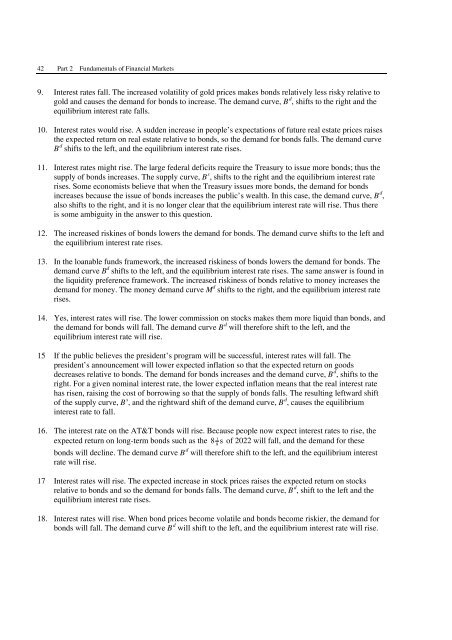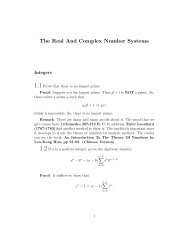Answers to End-of-Chapter Questions
Answers to End-of-Chapter Questions
Answers to End-of-Chapter Questions
You also want an ePaper? Increase the reach of your titles
YUMPU automatically turns print PDFs into web optimized ePapers that Google loves.
42 Part 2 Fundamentals <strong>of</strong> Financial Markets<br />
9. Interest rates fall. The increased volatility <strong>of</strong> gold prices makes bonds relatively less risky relative <strong>to</strong><br />
gold and causes the demand for bonds <strong>to</strong> increase. The demand curve, B d , shifts <strong>to</strong> the right and the<br />
equilibrium interest rate falls.<br />
10. Interest rates would rise. A sudden increase in people’s expectations <strong>of</strong> future real estate prices raises<br />
the expected return on real estate relative <strong>to</strong> bonds, so the demand for bonds falls. The demand curve<br />
B d shifts <strong>to</strong> the left, and the equilibrium interest rate rises.<br />
11. Interest rates might rise. The large federal deficits require the Treasury <strong>to</strong> issue more bonds; thus the<br />
supply <strong>of</strong> bonds increases. The supply curve, B s , shifts <strong>to</strong> the right and the equilibrium interest rate<br />
rises. Some economists believe that when the Treasury issues more bonds, the demand for bonds<br />
increases because the issue <strong>of</strong> bonds increases the public’s wealth. In this case, the demand curve, B d ,<br />
also shifts <strong>to</strong> the right, and it is no longer clear that the equilibrium interest rate will rise. Thus there<br />
is some ambiguity in the answer <strong>to</strong> this question.<br />
12. The increased riskines <strong>of</strong> bonds lowers the demand for bonds. The demand curve shifts <strong>to</strong> the left and<br />
the equilibrium interest rate rises.<br />
13. In the loanable funds framework, the increased riskiness <strong>of</strong> bonds lowers the demand for bonds. The<br />
demand curve B d shifts <strong>to</strong> the left, and the equilibrium interest rate rises. The same answer is found in<br />
the liquidity preference framework. The increased riskiness <strong>of</strong> bonds relative <strong>to</strong> money increases the<br />
demand for money. The money demand curve M d shifts <strong>to</strong> the right, and the equilibrium interest rate<br />
rises.<br />
14. Yes, interest rates will rise. The lower commission on s<strong>to</strong>cks makes them more liquid than bonds, and<br />
the demand for bonds will fall. The demand curve B d will therefore shift <strong>to</strong> the left, and the<br />
equilibrium interest rate will rise.<br />
15 If the public believes the president’s program will be successful, interest rates will fall. The<br />
president’s announcement will lower expected inflation so that the expected return on goods<br />
decreases relative <strong>to</strong> bonds. The demand for bonds increases and the demand curve, B d , shifts <strong>to</strong> the<br />
right. For a given nominal interest rate, the lower expected inflation means that the real interest rate<br />
has risen, raising the cost <strong>of</strong> borrowing so that the supply <strong>of</strong> bonds falls. The resulting leftward shift<br />
<strong>of</strong> the supply curve, B s , and the rightward shift <strong>of</strong> the demand curve, B d , causes the equilibrium<br />
interest rate <strong>to</strong> fall.<br />
16. The interest rate on the AT&T bonds will rise. Because people now expect interest rates <strong>to</strong> rise, the<br />
1<br />
expected return on long-term bonds such as the 8 s <strong>of</strong> 2022 will fall, and the demand for these<br />
8<br />
bonds will decline. The demand curve B d will therefore shift <strong>to</strong> the left, and the equilibrium interest<br />
rate will rise.<br />
17 Interest rates will rise. The expected increase in s<strong>to</strong>ck prices raises the expected return on s<strong>to</strong>cks<br />
relative <strong>to</strong> bonds and so the demand for bonds falls. The demand curve, B d , shift <strong>to</strong> the left and the<br />
equilibrium interest rate rises.<br />
18. Interest rates will rise. When bond prices become volatile and bonds become riskier, the demand for<br />
bonds will fall. The demand curve B d will shift <strong>to</strong> the left, and the equilibrium interest rate will rise.
















